The ADATA Premier SP550 SSD Review: A Second Look At Silicon Motion's SM2256 Controller
by Billy Tallis on March 23, 2016 8:30 AM ESTRandom Read Performance
The random read test requests 4kB blocks and tests queue depths ranging from 1 to 32. The queue depth is doubled every three minutes, for a total test duration of 18 minutes. The test spans the entire drive, which is filled before the test starts. The primary score we report is an average of performances at queue depths 1, 2 and 4, as client usage typically consists mostly of low queue depth operations.
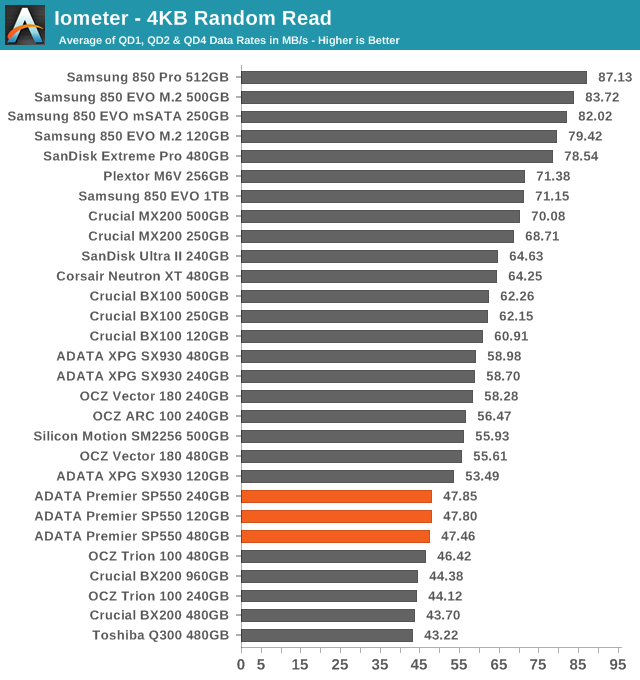
The SP550's random read performance is slightly higher than most of the TLC-based competition, but significantly slower than the SM2256 prototype with Samsung 19nm TLC managed. There's still a clear gap between the MLC drives and most of the TLC drives. The Samsung 850 EVO and SanDisk Ultra II are still the only TLC drives that can compete against MLC.
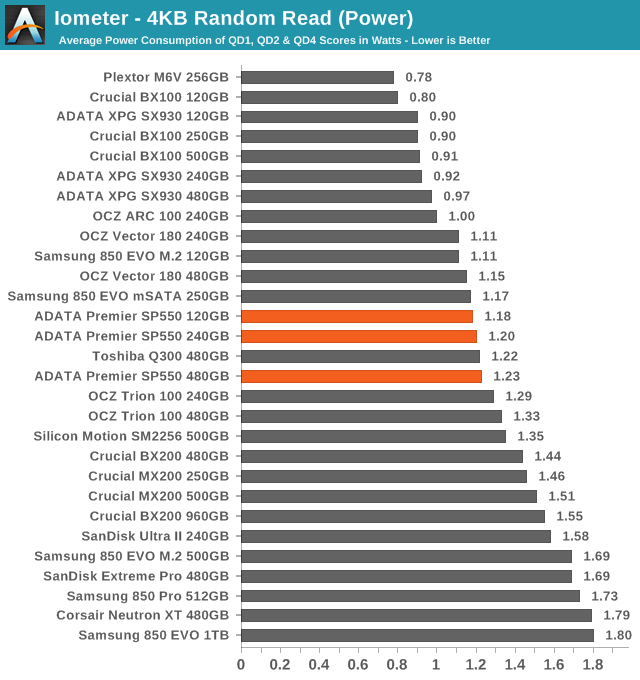
The SP550's power consumption is about average. TLC flash usually only has a slight disadvantage for read power and Silicon Motion's very efficient controller offsets that for the SP550.
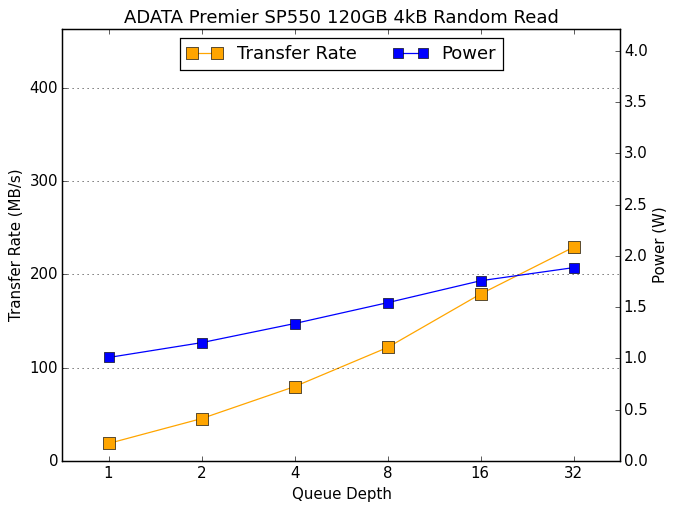 |
|||||||||
Looking at performance over various queue depths, all three capacities of the SP550 perform very similarly at low depths, with performance that starts quite low and doesn't increase very steeply. At higher queue depths the 120GB SP550 isn't able to scale up performance as much as the larger capacities, and even the 480GB model can't crack 300MB/s while high-end SATA drives top out around 400MB/s.
Random Write Performance
The random write test writes 4kB blocks and tests queue depths ranging from 1 to 32. The queue depth is doubled every three minutes, for a total test duration of 18 minutes. The test is limited to a 16GB portion of the drive, and the drive is empty save for the 16GB test file. The primary score we report is an average of performances at queue depths 1, 2 and 4, as client usage typically consists mostly of low queue depth operations.
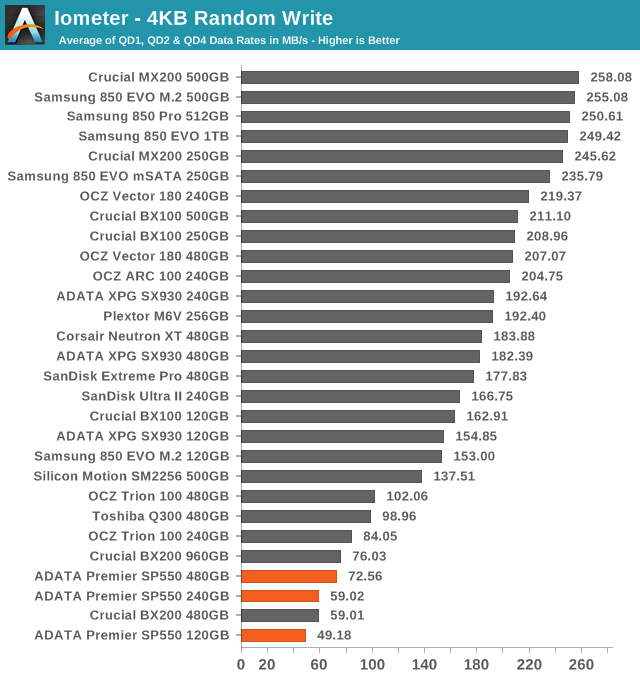
Random write performance is the SP550's biggest weakness. It beats the Crucial BX200 at equivalent capacities, but falls well behind everything else. While the steady-state random write performance was relatively good, this performance on this shorter test does not impress.
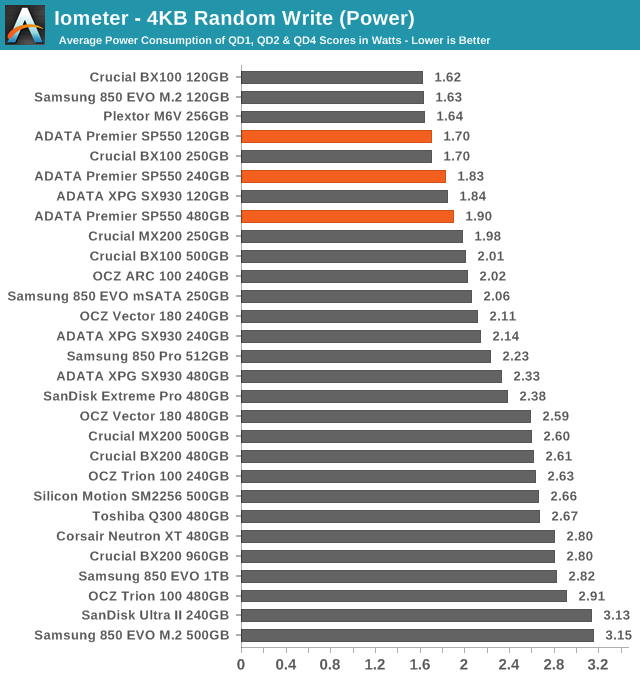
The power consumption of the SP550 on the random write test is very good, but given the bad performance there's no efficiency advantage.
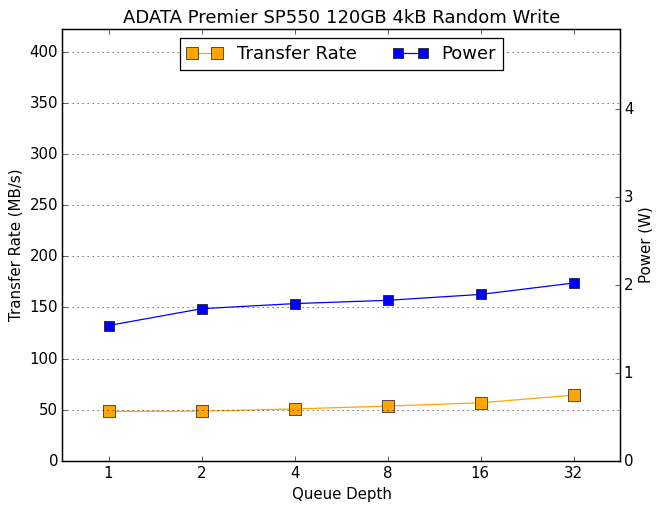 |
|||||||||
The SP550's random write speed doesn't scale much with queue depth. Fortunately, neither does the power consumption—a welcome change from the Crucial BX200. The OCZ Trion 100 and Toshiba Q300 also don't scale, but everything else does to at least some extent, including the SM2256 prototype.










25 Comments
View All Comments
zmeul - Wednesday, March 23, 2016 - link
I have the 120GB version and I'm disapointed in it - after just one month it started showing cell voltage drift and on the 2nd month it gotten worse: https://i.imgur.com/l3zonQn.pngnote: it's on a SATA2
A-Data offers no FW update for this drive
hojnikb - Wednesday, March 23, 2016 - link
Thats pretty much what you can expect with any sub 20nm TLC drive.zmeul - Wednesday, March 23, 2016 - link
well, I wish I knew that before I bought itbut neither Anand or any other site does this kind of "over time" testing
Samus - Thursday, March 24, 2016 - link
Basically you've found out first hand: AVOID any TLC drive, even TLC VNAND from Samsung isn't immune to what you are experiencing. At least you only spent $40. I still think the BX100 and OCZ ARC 100 are\were the best value, but they've spiked in price because they are no longer in production and the BX200\Trion 100/150 are a joke. My cheap go to drives now are Sandisk SSD Plus. Super cheap drive, still MLC, and suspect a reliable Marvell controller. Even the Sandisk Z400s is a reliable drive if you can get over the pretty poor performance...at least it isn't TLC performance.The laws of physics are being toyed with using NAND in TLC mode. You can't reliable store 3 values in a binary state. My childish layman's explanation goes like this: With SLC it was simple because if it was "on" it was a 1. With MLC if it was "on" it was a 1 and if it was "off" it was a 1. Using TLC, if its "on" it's a 1 if it's "off" its a 1 and if its "half" it's a 1. LOL
hojnikb - Thursday, March 24, 2016 - link
Actually, vnand tlc is just fine and possibly better than ~15nm MLC.Much larger cells offset the 3 bit per cell disadvantage.
Samus - Thursday, March 24, 2016 - link
I get that it's 40nm, so "leakage" isn't really an issue, but it still suffers from TLC's inherently poor write performance. I still prefer MLC. Especially since, as it stands right now, MLC and TLC drives are virtually the same price. I still pickup old Crucial M500's and Intel SSD320/X25-M's...and occasionally you can find new M500's in retail (Microcenter has the M550 256GB models for $60 right now)Well, they DID. I bought the last 5 at my local store I guess. http://www.microcenter.com/product/453561/256GB_SA...
They have the M500 240GB new for $67.99. Quality Marvell controller, MLC NAND, proven firmware and reliability. Until TLC drives are half that price for the same capacity I don't see what the big deal is.
KAlmquist - Thursday, March 24, 2016 - link
I'm have a hard time believing that 16nm TLC NAND is a good idea. The problems that Samsung has had with data degradation on the 840 EVO suggests that even with 19nm TLC NAND the cell size is too small. While the reviewed drive is priced attractively, I'd be more inclined to buy an MLC drive, or the Samsung EVO 850, which is TLC but with a large cell size.LarsBars - Thursday, March 24, 2016 - link
The MU02 firmware update for the Crucial BX200 resolved the strange ATTO plots that were mentioned in this review. At least for me.jabber - Friday, March 25, 2016 - link
Mmmmm the BX200. The one I got in to test finally bottomed out at a super 40MBps write speed. That was about 6 weeks ago with the latest firmware then. BX200 = Junk. The BX100, now that was and still is a quality drive.bogdan_kr - Saturday, March 26, 2016 - link
@Billy TallisI would like to ask about AnandTech Storage Bench - Light. How long (typically) does it take to finish this bench?
I mean I can see it is designed to read and write about 41GB of data. SP550 480GB finished it with 299.02 MB/s average data rate score so does that mean it took about 140 seconds?